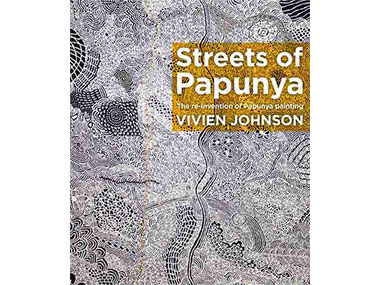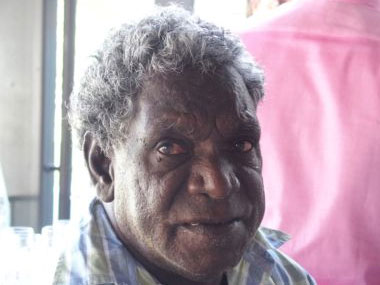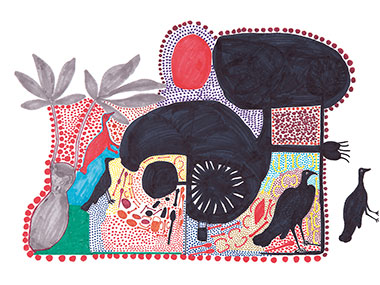CHRISTMAS BOOKS

Cover for Vivien Johnson's 'Streets of Papunya'
Jeremy Eccles | 21.12.15
Author: Jeremy Eccles
News source: Review
The spate of Aboriginal art publishing seems to have diminished just a tad this year. Which may be no bad thing for avid collectors with limited shelf space! They do all tend to be BIG books.
Undoubtedly the must-buy of the year for people wanting the broadest sweep of the culture rather than a monograph on a single artist is the British Museum's catalogue accompanying their excellent 'Indigenous Australia : enduring civilisation' show back in April. While its domestic equivalent at the National Museum chose to go for the political priority of linking the fabulous British Museum objects on loan to the tribes and language groups today which recognised them as their heritage, Gaye Sculthorpe in London brought together a fine bunch of writers – including John Carty, Howard Morphy, Maria Nugent, Ian Coates and Lissant Bolton – to really situate her objects in the Country where they arose. Pictures of that Country, contemporary art and many more objects than could be fitted into the BM's limited space also get into the catalogue.
Another strong contender for Indigenous book of the year has to be Vivien Johnson's continuing pursuit of the art that kicked off the whole painting revolution 40+ years ago in Papunya. Having feted the Papunya Tula organisation, the basically Pintupi side of the business which long ago left the township of Papunya itself and headed west, in the magisterial 'Lives of the PTA Artists', she's now brought it all back home with 'Streets of Papunya' (published by New South Books). There she found not only streets named after all the great ancestors of the art movement, but a thriving mob operating as Papunya Tjupi. Actually, Johnson knew full well they were there because she was participant in the establishment of the new art centre which revived artist practice in the old town back in 2005/6.
Now she's hailed their survival and Sherlock Holmesed through their relationships with the past – both blood and art. I look forward to reporting more fully on this important book in 2016.
In purely promotional terms, the single artist monograph won't go away. And they're very good at it in Perth – perhaps because they see themselves as so far from the money Over East? So Seva Frangos, dealer and former WA Art Gallery curator has taken Tiwi master Timothy Cook under her wing and quite naturally wants to sell his art for him. The book, 'Dancing with the Moon' (published by UWA Publishing) naturally concentrates on his mature works featuring the moon of the Tiwi Kulama ceremony – often combined with the cross of the influential Catholic missionaries on Bathurst and Melville Islands – and perhaps offers slightly too many similar images of Cook's work. But there's also a range of early works and works of his influential elders like Kitty Kantilla and Freda Warlapinni, even Tiwi work collected by the Mountford expedition of the 1940s. Commentary ranges from academic to useful – Judith Ryan from the NGV, as ever, comes up trumps.
The Mossensons are also Perth-base dealers with a much-admired capacity for developing artists that others have ignored. Adelaide's recent Tarnanthi Festival featured Utopian footy players wherever you looked from huge banners at the gallery's entrance to the successful kids play area by Dini Kunoth Kemarre and Josie Kunoth Petyarre, and at least three appearances by the not-well known Kimberley artist, Ngarra. To back this up, the Mossenson Art Foundation has produced the first of two books on Ngarra – unpromisingly entitled, 'the texta drawings'.
With almost any other Aboriginal artist, you could dismiss such doodles out of hand. With Ngarra (1920/2008), you have a man who operated outside the world that Nicolas Rothwell so often condemns for its conforming to government and institutional precepts with a little help from anthropologist Kevin Shaw who obviously felt there was much to learn from this fully-initiated Andinyin man – who entrusted the anthropologist enough to leave Shaw to organise his burial on the remote Country where he'd spent his youth with a group of 'myall' elders around his grandparents.
That alone is worth the price of the book, though entering Ngarra's unpredictable imagination through his art is a marvellous bonus. Given current debates about the sacredness of Sunday in relation to the penalty rates that go with it, Ngarra offers his own thoughts on the state of social wellness before the welfare state in the work, 'Bidniangarri'. 'No shop, just bush tucker; and bushman and lady they work seven days a week, no stop. Those days we couldn't know Saturday and Sunday. Later on, union working mob at meatworks made Saturdays, missionary mob made Sunday, and gov'ment and cattle station made Monday to Friday'!!!
UWA Publishing (A Division of University of WA)
Mossenson Art Foundation
New South Publishing
British Museum
Share this:
»  del.icio.us
»
del.icio.us
»  Digg it
»
Digg it
»  reddit
»
reddit
»  Google
»
Google
»  StumbleUpon
»
StumbleUpon
»  Technorati
»
Technorati
»  Facebook
Facebook
Contact Details

The Tiwi artist Timothy Cook at the Darwin launch of the mongraph about his work, 'Dancing with the Moon'

Ngarra's 'Ngarrankarni Changeover Times', the cover artwork for the Mossenson Art Foundation book
Further Research
Artists: Dini Kunoth Kemarre | Freda Warlapinni | Josie Kunoth Petyarre | Kitty Kantilla | Ngarra | Timothy Cook
News Tags: British Museum | Diane Mossenson | Gaye Sculthorpe | Jeremy Eccles | Papunya Tjupi | Papunya Tula | Seva Frangos | Tarnanthi Festival | Tiwi art | Vivien Johnson
News Archive
- 11.10.17 | RETURN OF MUNGO MAN
- 10.10.17 | TARNANTHI 2017
- 11.08.17 | Natsiaas 2017
- 08.08.17 | ABORIGINAL ART ECONOMICS
- 02.08.17 | SCHOLL'S NEXT MOVE
- 20.07.17 | APY ART DOMINATES THE WYNNE
- 17.07.17 | Anangu Artist Wins $100,000 Prize
- 14.07.17 | The End of AAMU
- 13.07.17 | YOU ARE HERE
- 11.07.17 | ART ACROSS THE COUNTRY
- 11.07.17 | TARNANTHI IN OCTOBER
- 05.07.17 | TJUNGUṈUTJA - from having come together
- 02.07.17 | BENNELONG
- 27.06.17 | JIMMY CHI
- 23.06.17 | Blak Markets at Barangaroo
Advertising

